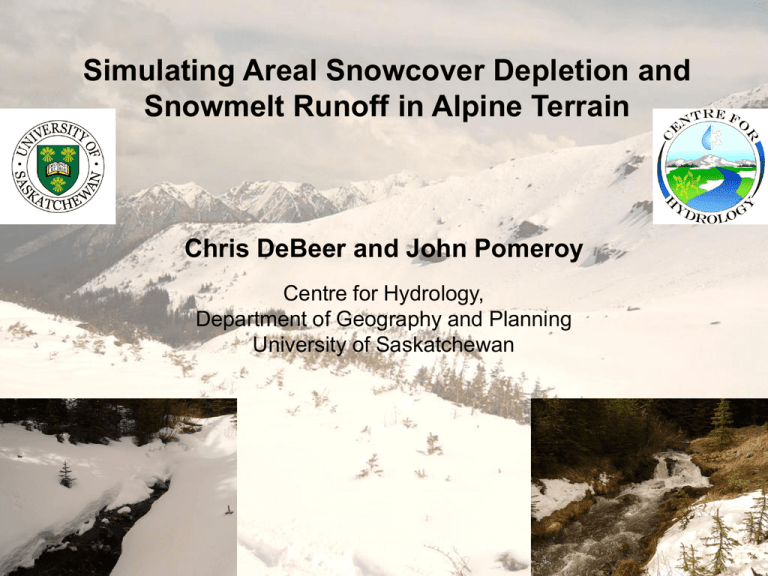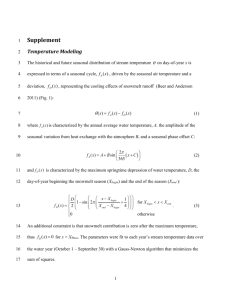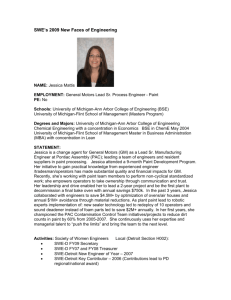Simulating Areal Snowcover Depletion and Snowmelt Runoff in Alpine Terrain
advertisement

Simulating Areal Snowcover Depletion and Snowmelt Runoff in Alpine Terrain Chris DeBeer and John Pomeroy Centre for Hydrology, Department of Geography and Planning University of Saskatchewan Background • Snowmelt runoff from Rocky Mountains is an important water resource • High uncertainty in the future hydrological response to climate and/or landcover change • Important to be able to better understand and predict likely changes for future water management – Requires robust and physically based models for simulating snow processes Variability of Alpine Snow Processes • Complexities in terrain and vegetation affect snow accumulation, redistribution, and melt – High spatial variability in snow water equivalent (SWE) – Large variation in energy for snowmelt during the spring • Leads to a patchy snowcover as the spring progresses • Significantly affects timing, rate, and magnitude of meltwater generation Areal Snowcover Depletion (SCD) • Melt rate computations applied to a distribution of SWE yield snowcovered area (SCA) over time (SCD curve) SCA p(SWE)dSWE Ma Frequency distribution of SWE Derived SCD curve 1 0.06 SCA = 0.92 0.9 0.05 0.8 0.7 Ma 100 mm 0.03 0.02 SCA p (SWE) 0.04 0.5 SCA = 0.45 0.4 Ma 200 mm 0.01 Ma 100 mm 0.6 Ma 200 mm 0.3 0.2 Ma 350 mm Ma 350 mm 0.1 0 0 0 100 200 300 SWE (mm) 400 500 600 0 100 200 300 SCA = 0.05 400 Melt depth (mm) 500 600 Problems with SCD Approach in Alpine Terrain • The approach assumes uniform melt rate over the SWE distribution – Energy balance melt rate computations depend on snowpack state (e.g. depth, density, SWE, temperature, etc.) – Melt rates are not uniform in alpine terrain • Further problems with new snowfall part way through melt Study Objectives • Develop new theoretical framework for areal snowcover depletion (SCD) and meltwater generation • Test framework using observations in alpine basin • Determine how variability of SWE and snowmelt energy affect areal SCD and meltwater generation • Incorporate framework within hydrological model and examine influence of variability on hydrograph Development of Theoretical Framework • Framework for areal SCD based on lognormal distribution 800 700 SWE (mm) SWE SWE (1 K CV) 4 SWE = 200(1+K(0.4)) 600 500 5 400 10 300 CV = 1.0 15 days 200 100 CV = 0.8 0 3 -4 -2 0 SWE / SWE CV = 0.6 0.75 SCA 0 -1 0.5 0.25 0 1 2 3 4 5 K 6 0 0 0 10 6 CV = 0.0 1 -2 4 SCD curve from uniform 30 mm/day applied snowmelt 1 CV = 0.2 -3 2 K CV = 0.4 2 2 50 80 90 95 99 99.9 5 10 Days 15 20 Development of Theoretical Framework • Framework handles other important aspects of spatial snowmelt and new snowfall during spring Line representing the distribution can be discretized Melt depth for 50 mm initial SWE Melt depth for 100 mm initial SWE 200 150 Following melt New snow added uniformly over remaining distribution 100 Snowmelt Kmin, i Kmin, ii 0 1 3 2 50 SWE SWE (mm) Initial distribution Foot Subsequent accumulation Frequency factor, K Kmin, 1 Kmin, 2 0 Field Study Site • Marmot Creek Research Basin, Kananaskis Country, Alberta Field Study Site • Focused data collection at Fisera Ridge and Upper Middle Creek Mt. Allan Field Methods and Observations • Data collection over three years (2007-09) involved: – Meteorological observation – Snow surveys – Daily terrestrial photos – Lidar snowcover mapping North Facing – Streamflow measurement Station Ridgetop Station Southeast Facing Station Field Methods and Observations • 100’s of snow surveys over 3 years • Setup and maintenance of many instruments and met stations • Dozen’s of manual stream discharge measurements Terrestrial Oblique Photo Correction 1) Viewshed mask created from camera perspective 2) DEM projection in camera coordinate system 3) Correspondence established between DEM cells and image pixels 4) Image reprojection in DEM coordinates 1 4 2&3 Areal Snowcover Observations Time lapse digital photography used to monitor areal SCD May 13, June July 1, 4, 9, 7, 10, 14, 17, 19, 22, 26, 29, 31, 2,2007 4, 7, 10, 13, 18, 21, 24, 27, 2007 2007 2007 2007 2007 Snowmelt Modelling and Validation • Snowpack evolution simulated using the Snobal energy balance model within Cold Regions Hydrological Model (CRHM) platform Shortwave and longwave radiation inputs corrected for slope, aspect, skyview fraction using algorithms in CRHM (Qm = LVE + H - K↑ + K↓ + L↓ - L↑ + G - dU/dt) Lv E H K↑ K↓ L↓ L↑ Soil layer E U Active layer Lower layer P U G R Snowmelt Modelling and Validation • Model performs well for depth, SWE, internal energy 2 1 0 1-Apr 15-Apr 29-Apr 13-May 27-May 10-Jun 24-Jun 1 0 1-Apr 600 300 0 1-Apr 15-Apr 29-Apr 13-May 27-May 10-Jun 24-Jun Depth (mm) Depth (mm) Simulated SWE (mm) Measured SWE (mm) 600 300 0 1-Apr 15-Apr 29-Apr 13-May 27-May 10-Jun 24-Jun -25 1-Apr 15-Apr 29-Apr 13-May 27-May 10-Jun 24-Jun Date (2008) Date (2009) Snow temp (°C) Simulated active layer T Measured active layer T Simulated lower layer T Measured lower layer T Simulated SWE (mm) Measured SWE (mm) 900 Date (2008) Snow temp (°C) 15-Apr 29-Apr 13-May 27-May 10-Jun 24-Jun Date (2009) 900 -15 Simulated depth (m) 2 Date (2008) -5 Measured depth (m) 2009 3 Depth (m) Depth (m) Measured depth (m) Simulated depth (m) 2008 3 0 -5 -10 Simulated active layer T Measured active layer T Simulated lower layer T Measured lower layer T -15 1-Apr 15-Apr 29-Apr 13-May 27-May 10-Jun 24-Jun Date (2009) Effects of Snow Mass and Internal Energy Shallow CC Intermediate CC Deep CC Shallow T Intermediate T Deep T 0 -2 -4 -6 -8 22-Apr 23-Apr 24-Apr 25-Apr 26-Apr 27-Apr 28-Apr 29-Apr 30-Apr 1-May 2-May 3-May 4-May 5-May 6-May Date (2008) Melt rate (mm/day) Cold Content: Energy required to bring snowpack to 0 °C and satisfy liquid water holding capacity Cold content (MJ/m 2) Snowpack temperature (°C) • Differences in initial state have large influence on computation of snowmelt timing and rate 20 15 10 Shallow snow Intermediate snow Deep snow 5 0 22-Apr 23-Apr 24-Apr 25-Apr 26-Apr 27-Apr 28-Apr 29-Apr 30-Apr 1-May 2-May 3-May 4-May 5-May Date (2008) Spatial – Temporal Snowmelt Variability SE-facing slope 26-Apr 28-Apr 30-Apr 2-May 4-May 12 9 6 3 Melt rate (mm/day) a 50 0 40 14-May 18-May 21-Jun 30 16-May 16-Jun 20 10 0 0 400 800 1200 0 SWE (mm) 15 50 N-facing slope 26-Apr 28-Apr 30-Apr 2-May 4-May 12 9 6 400 800 1200 SWE (mm) Melt rate (mm/day) a Melt rate (mm/day) a • Differences in melt energy and SWE lead to large differences in snowmelt that change over time Melt rate (mm/day) a 15 3 0 14-May 18-May 21-Jun 40 16-May 16-Jun 30 20 10 0 0 400 800 SWE (mm) 1200 0 400 800 SWE (mm) 1200 Landscape Disaggregation for SCD Simulation S-facing slope 2000 0.3 0.25 1500 SWE measurements 1000 SWE = 157.0K + 223.6 f (SWE) SWE (mm) 0.2 2 R = 0.96 Theoretical distribution 0.15 0.1 500 0.05 00 15 50 00 13 12 50 0 0 0 0 0 K 10 10.0 90 8.0 75 6.0 60 4.0 45 2.0 30 0 0.0 15 -2.0 0 0 0 SWE (mm) N-facing slope SWE = 273.5K + 290.9 2500 R2 = 0.97 0.25 2000 SWE (mm) 0.2 1500 f (SWE) 1000 SWE measurements Theoretical distribution 0.15 0.1 0.05 500 K SWE (mm) 00 15 50 13 00 12 50 0 0 0 0 0 10 90 15.0 75 10.0 60 5.0 45 0 0.0 30 -5.0 0 0 0 15 • SWE values on different slopes fit theoretical lognormal distribution Simulation of Areal SCD over Landscape Overall basin Simulated overall SCD curve 1 NS = 0.78 RMSE = 0.15 0.5 0 10-May 20-May 30-May 9-Jun Date (2008) Observed north facing SCD curve SCA fraction 1 North 0.5 facing 0 10-May 9-Jul 1 NS = 0.89 NS =RMSE 0.92 = 0.10 0.5 0 10-May 20-May SCA fraction 29-Jun Observed overall SCD curve RMSE = 0.09 20-May 30-May 30-May 9-Jun 9-Jun Date (2008) 19-Jun (2008) Observed south facingDate SCD curve South facing 19-Jun Simulated north facing SCD curve Simulated overal SCD curve SCA fraction 19-Jun 29-Jun 29-Jun 9-Jul 9-Jul Simulated south facing SCD curve 1 NS = 0.84 RMSE = 0.16 0.5 0 10-May 20-May 30-May 9-Jun 19-Jun 29-Jun 9-Jul Date (2008) Observed east facing SCD curve East facing SCA fraction • Framework applied to predict areal SCD • Results were improved by considering separate distributions and melt rates on each slope SCA fraction Observed overall SCD curve Simulated east facing SCD curve 1 NS = 0.94 RMSE = 0.06 0.5 0 10-May 20-May 30-May 9-Jun Date (2008) 19-Jun 29-Jun 9-Jul Influence of “Inhomogeneous” Snowmelt 150 mm initial Observed 300 mm initial 1 SCA fraction • Earlier and more rapid melt of shallow snow on some slopes led to an initial acceleration of SCD Inhomogenous 850 mm initial 0.75 0.5 N facing slope 0.25 24-Apr 27-Apr 30-Apr 3-May 6-May Date (2008) Inhomogenous 850 mm initial 150 mm initial Observed Inhomogenous 850 mm initial 300 mm initial SCA fraction SCA fraction 300 mm initial 1 1 0.75 0.5 150 mm initial Observed S facing slope 0.25 24-Apr 27-Apr 30-Apr 3-May Date (2008) 6-May 0.75 0.5 0.25 24-Apr Overall basin 27-Apr 30-Apr Date (2008) 3-May 6-May Spatial Variability of Meltwater Generation • Variability in melt over landscape and SWE dist’s. affects location, extent, and timing of meltwater generating area April 26 April 29 May 5 May 2 0–5 mm/day 5 – 10 mm/day 10 – 20 mm/day exposed ground forested areas cliffs Hydrological Model Development • Process-based and conceptual model with spatial structure based on topography, land cover, and SWE distributions 800 14% of distribution 700 SWE (mm) 600 500 SWE = 273.5K + 290.9 R2 = 0.97 19% of distribution 400 300 34% of distribution 33% of dist. -1.5 200 100 0 0.0 1.5 K Model Evaluation for Snowmelt Hydrograph • Model is capable of producing reasonable hydrographs with correct volume of runoff Total Discharge Component Hydrographs Measured Hydrograph Simulated Hydrograph 0.2 0.1 0 01-May N-facing slope S-facing slope E-facing slope Cirque floor N-facing forest S-facing forest 0.075 15-May 29-May 12-Jun 26-Jun 10-Jul Discharge rate (m3/s) Discharge rate (m3/s) 0.3 0.05 0.025 0 01-May 24-Jul 15-May 29-May Date (2009) 0.2 0.1 15-May 29-May 12-Jun 26-Jun Date (2007) 10-Jul 24-Jul 10-Jul 24-Jul N-facing slope S-facing slope E-facing slope Cirque floor N-facing forest S-facing forest 0.075 Discharge rate (m3/s) Discharge rate (m3/s) Simulated Hydrograph 0 01-May 26-Jun Date (2009) Measured Hydrograph 0.3 12-Jun 0.05 0.025 0 01-May 15-May 29-May 12-Jun 26-Jun Date (2007) 10-Jul 24-Jul Hydrograph Sensitivity Analysis • Various simulation approaches were used to examine influence on the basin hydrograph Variable SWE dist. Variable Melt Measured Hydrograph Simulated Hydrograph 0.2 NS = 0.62 0.1 RMSE = 0.03 0 01-May 15-May 29-May 12-Jun 26-Jun 10-Jul 0.3 Discharge rate (m3/s) Discharge rate (m3/s) 0.3 NS = 0.53 0.1 RMSE = 0.03 0 01-May 15-May 29-May 12-Jun 26-Jun 24-Jul Measured Hydrograph NS = 0.39 0.1 RMSE = 0.04 Date (2009) 10-Jul 24-Jul 0.3 Discharge rate (m3/s) Simulated Hydrograph 0.2 0 01-May 15-May 29-May 12-Jun 26-Jun 10-Jul 24-Jul Date (2009) 3 Discharge rate (m /s) VariableSWE dist. Uniform Energy Simulated Hydrograph 0.2 Date (2009) 0.3 Measured Hydrograph Fixed SWE dist. Variable Melt Measured Hydrograph Fixed SWE dist. Uniform Energy Simulated Hydrograph 0.2 NS = 0.23 0.1 RMSE = 0.04 0 01-May 15-May 29-May 12-Jun 26-Jun Date (2009) 10-Jul 24-Jul Hydrograph Sensitivity Analysis • Other approaches were used to examine effects of forest canopy and soil depth, and inhomogeneous melt Measured Hydrograph Simulated Hydrograph Measured Hydrograph 0.3 Sim. - Inhomogeneous 3 Fixed SWE dist. - Uniform Energy; Uniform soil and canopy Discharge rate (m /s) 3 Discharge rate (m /s) 0.4 0.3 0.2 0.1 0 01-May 15-May 29-May 12-Jun 26-Jun 10-Jul 24-Jul Sim. - Homogeneous 0.2 0.1 0 01-May 15-May 29-May 12-Jun 26-Jun Date (2009) NS = -0.28 RMSE = 0.06 10-Jul 24-Jul Date (2009) Homogeneous Inhomogeneous NS = 0.47 NS = 0.62 RMSE = 0.04 RMSE = 0.03 Key Conclusions, Significance • Novel framework that allows for physical, yet spatially simple snowmelt and SCD simulation – Incorporation of sub-grid distributions of internal energy for melt computation • Application of the framework, together with a hydrological model showed the influence of the spatial variability of both SWE and snowmelt energy on areal SCD and snowmelt runoff in an alpine environment Key Conclusions, Significance • Important to take inhomogeneous melt into account for areal SCD simulations – Implications for remote sensing, climate models and modelling applications using depletion curves • Effects are not as important for snowmelt runoff and hydrograph simulation, as other processes tend to overwhelm the response – Still important to account for spatial variability of snowmelt energy on the slope, and land cover scale Thank You • • • • • • • NSERC CFCAS Canada Research Chairs Programme University of Calgary Biogeosciences Institute Nakiska Ski Resort Applied Geomatics Research Group Students and Staff of Centre for Hydrology




